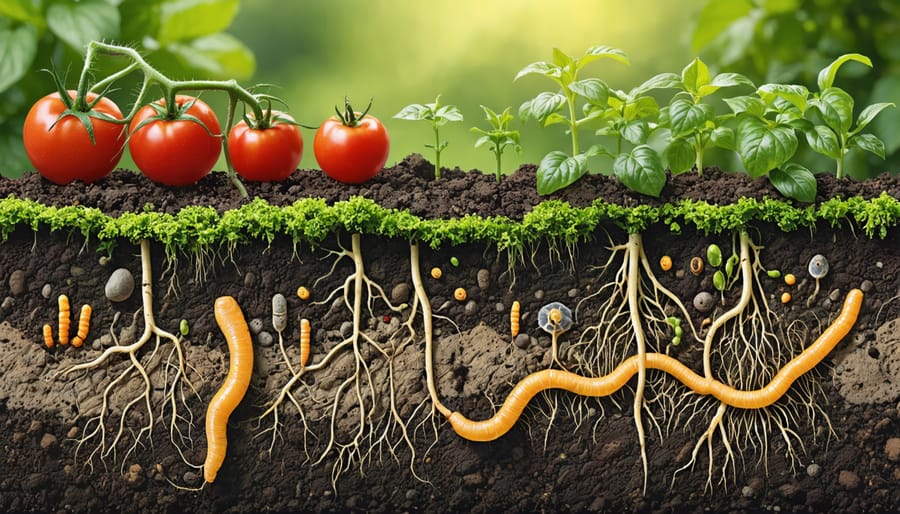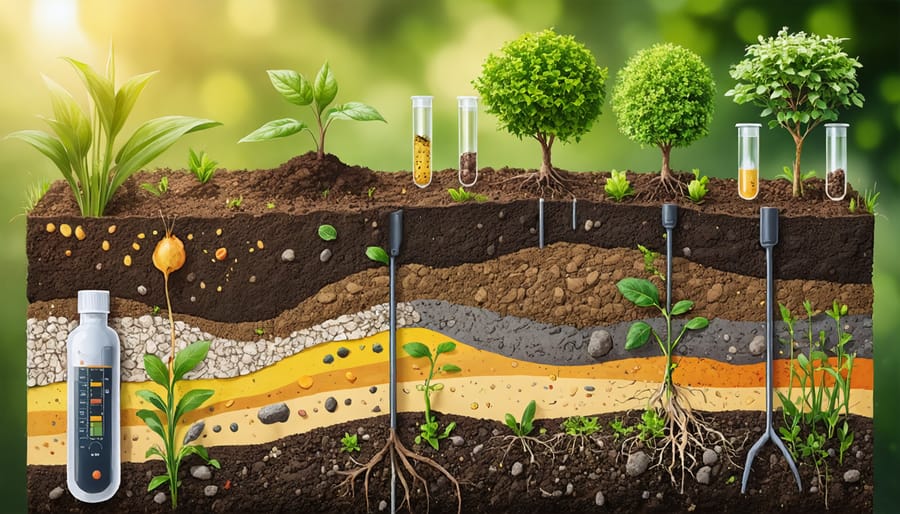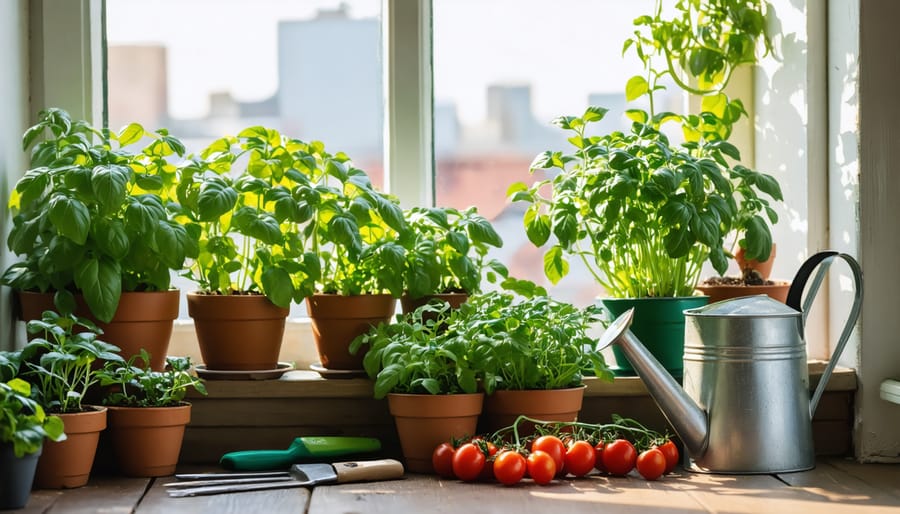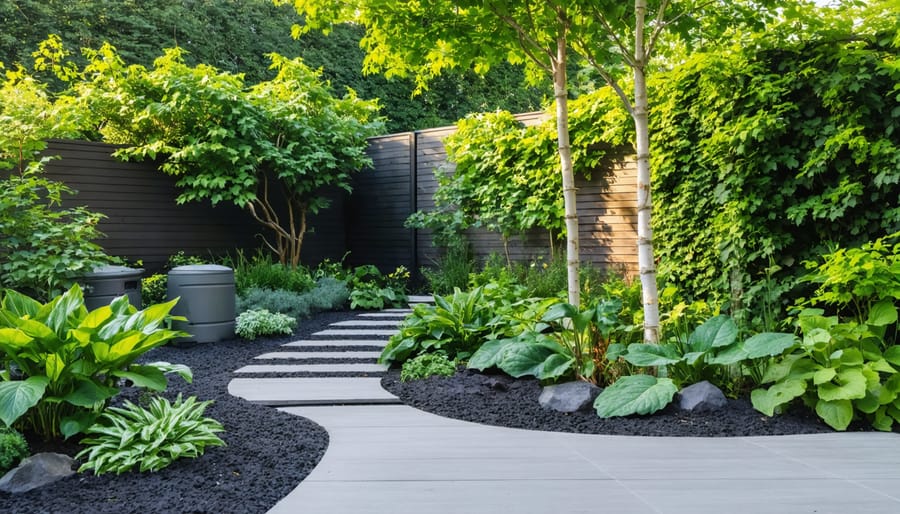Beneath every thriving garden lies a complex web of life that transforms ordinary dirt into living, nurturing soil. Healthy soil organics aren’t just a gardening trend – they’re the fundamental building blocks of sustainable growing and the secret behind those enviably lush gardens that seem to flourish effortlessly. By understanding and nurturing the delicate balance of organic matter, beneficial microorganisms, and natural nutrients, gardeners can create an underground ecosystem that powers plant growth from the roots up.
Think of healthy soil as nature’s original recycling system: fallen leaves, kitchen scraps, and yard waste transform into black gold that feeds your plants while fighting pests and disease naturally. Whether you’re growing prize-winning tomatoes or creating a backyard paradise, the journey starts with what’s happening beneath your feet. The good news? Building healthy soil isn’t complicated – it’s about working with nature’s own processes and giving soil life the conditions it needs to thrive.
In this guide, we’ll explore practical ways to enhance your soil’s organic matter, boost beneficial microbe populations, and create the perfect growing environment for whatever you wish to plant. Get ready to dig deeper into the fascinating world of soil health and discover how small changes in your gardening practices can yield remarkable results.
What Makes Soil Truly Healthy?
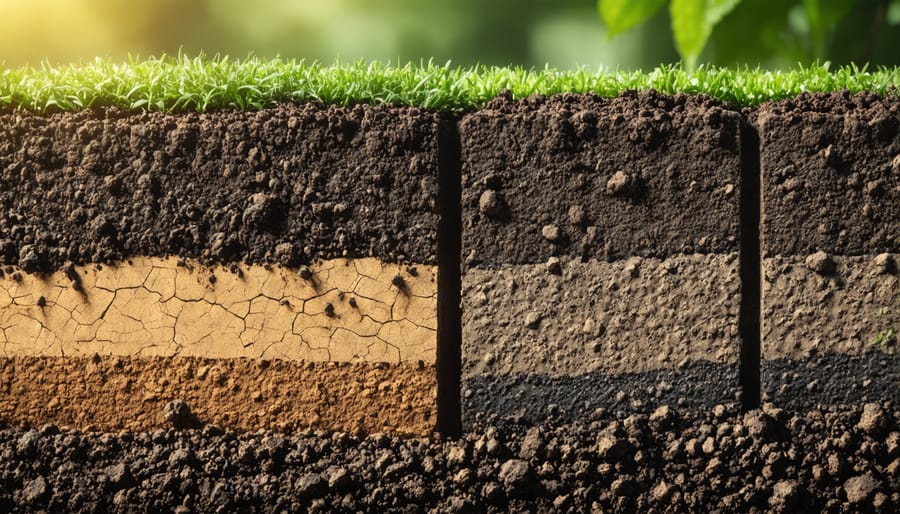
The Living Soil Web
Imagine your garden soil as a bustling underground city, teeming with billions of helpful microorganisms working together in perfect harmony. These tiny heroes – bacteria, fungi, protozoa, and other microscopic creatures – form what we call the soil food web. Each member plays a crucial role in breaking down organic matter and creating nutrient-rich soil that plants love.
Beneficial bacteria transform organic materials into plant-available nutrients, while fungi create vast networks that help plants communicate and share resources. These fungal networks, often called “nature’s internet,” can extend for miles underground! Protozoa and nematodes keep harmful organisms in check while releasing nutrients through their natural life cycles.
The key to supporting this vibrant community lies in regular additions of organic matter like compost, mulch, and cover crops. These materials provide food and shelter for beneficial microorganisms, allowing them to thrive and multiply. When you feed the soil web, you’re essentially creating a self-sustaining ecosystem that naturally maintains soil health and promotes robust plant growth.
Remember, healthy soil is living soil. By nurturing these microscopic allies, you’re building a strong foundation for your garden’s success.
Essential Organic Components
A thriving garden starts with understanding the key organic components that make soil healthy and productive. At the heart of healthy soil are three main types of organic materials: fresh green matter, brown matter, and decomposed organic matter. Fresh green materials, like grass clippings and kitchen scraps, provide nitrogen and quick-release nutrients that feed beneficial soil microorganisms. Brown materials, including fallen leaves, straw, and wood chips, contribute carbon and help create soil structure.
Decomposed organic matter, often called humus, is the dark, crumbly material that gives soil its rich color and sweet earthy smell. This magical substance improves soil structure, enhances water retention, and creates the perfect environment for beneficial bacteria and fungi to thrive. Composted manure adds both nutrients and organic matter while improving soil texture.
Each of these components plays a unique role in building healthy soil. Green materials feed soil life, brown materials provide long-term structure, and decomposed matter binds it all together. When combined in the right proportions, these organic materials create a living ecosystem that supports strong plant growth and abundant harvests.
Building Your Soil’s Organic Foundation
Compost: Your Soil’s Best Friend
Composting is nature’s way of recycling, and it’s one of the most effective ways to create nutrient-rich soil for your garden. Think of compost as a gourmet meal for your soil – it’s packed with essential nutrients, beneficial microorganisms, and organic matter that plants absolutely love.
To start your composting journey, you’ll need a good mix of “green” and “brown” materials. Green materials include kitchen scraps, grass clippings, and fresh plant matter, while brown materials consist of dry leaves, straw, and paper products. Aim for a ratio of about 3:1 browns to greens to achieve the perfect balance.
Creating great compost is like baking a cake – it needs the right ingredients and conditions. Keep your pile moist (like a wrung-out sponge) and turn it regularly to provide oxygen. A well-maintained pile will break down in 3-6 months, producing dark, crumbly compost that smells like fresh earth.
When applying compost, work it into the top 6-12 inches of soil before planting, or use it as a mulch around established plants. Combined with other organic fertilization techniques, compost can transform even the poorest soil into a thriving ecosystem for your plants.
Remember, successful composting is a continuous cycle – as you harvest finished compost, keep adding fresh materials to start the next batch. Your garden will thank you with healthier plants and better yields!
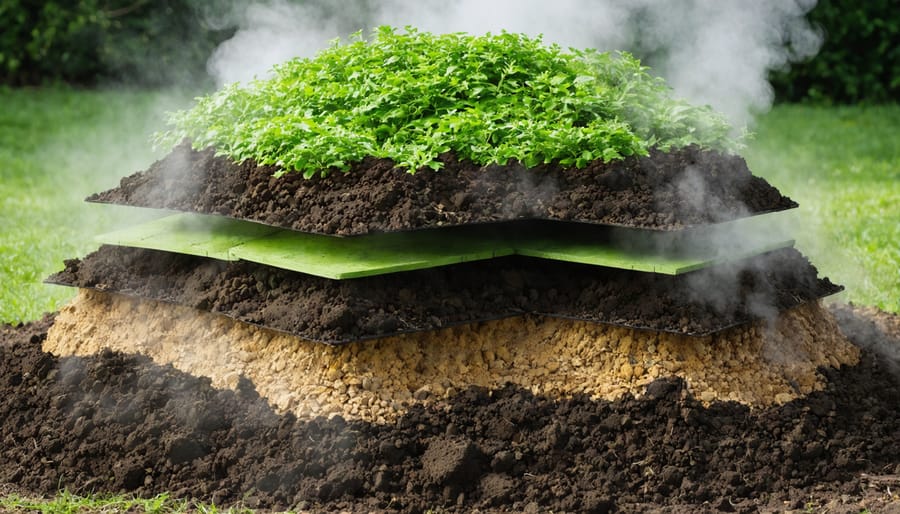
Cover Crops and Green Manures
Cover crops and green manures are like nature’s own soil-building powerhouses! These hard-working plants help create rich, healthy soil while protecting and nurturing your garden. When you plant cover crops like clover, rye, or buckwheat during off-seasons or between main crops, you’re essentially growing your own organic matter factory.
These plants work their magic in several ways. Their roots penetrate deep into the soil, breaking up compaction and creating channels for water and air. As they grow, they protect the soil from erosion and prevent weeds from taking hold. But the real magic happens when you cut them down and either till them into the soil or leave them on the surface as mulch – this is where they become “green manure.”
Legume cover crops like peas and beans are particularly valuable because they partner with beneficial bacteria to fix nitrogen from the air into the soil. This natural fertilizer production means less work for you and healthier soil for your plants.
For best results, try planting cover crops in fall after your main harvest, or in early spring before your growing season begins. You can also use them to rejuvenate tired garden beds or prepare new growing areas. Remember to cut them down before they set seed, usually when they start flowering, to get the maximum soil-building benefits.
Natural Amendments and Mulches
Natural amendments and mulches are your garden’s best friends when it comes to building healthy, living soil. Whether you’re practicing no-dig gardening methods or setting up a new raised bed gardening system, these organic materials work wonders for soil improvement.
Compost is the gold standard of soil amendments, providing a rich blend of nutrients and beneficial microorganisms. You can create your own using kitchen scraps, yard waste, and fallen leaves. Aged manure from herbivorous animals like horses, chickens, or rabbits adds valuable nutrients and improves soil structure.
For mulching, straw and hay provide excellent coverage while gradually breaking down to feed the soil. Wood chips work wonderfully for pathways and around perennial plants, though avoid using fresh chips directly in growing areas. Leaf mold, created from decomposed autumn leaves, makes an outstanding soil amendment and mulch that mimics nature’s own soil-building process.
Grass clippings (from untreated lawns) can be used as a nitrogen-rich mulch, while seaweed offers a boost of trace minerals and growth hormones. Even cardboard and newspaper can serve as effective weed barriers when layered with organic materials above them.
Remember to apply mulches in layers 2-4 inches thick, keeping them slightly away from plant stems to prevent rot. As these materials break down, they’ll continuously feed your soil and improve its structure.
Maintaining Long-Term Soil Health
Seasonal Soil Care Calendar
Keeping your soil healthy is a year-round commitment that strengthens your garden’s ecosystem and enhances soil’s role in climate resilience. Let’s break down the seasonal rhythm of organic soil care:
Spring (March-May):
– Test soil pH and nutrient levels as soon as soil thaws
– Add well-aged compost to garden beds
– Work in cover crops from fall as green manure
– Apply light mulch layer to retain moisture
Summer (June-August):
– Maintain 2-3 inch organic mulch layer
– Add grass clippings between rows
– Incorporate kitchen scraps into compost
– Water deeply but less frequently to encourage deep root growth
Fall (September-November):
– Add fallen leaves to beds
– Plant cover crops like clover or rye
– Work in final batch of season’s compost
– Apply thick mulch for winter protection
Winter (December-February):
– Continue composting kitchen scraps
– Plan next year’s rotation
– Order organic amendments
– Monitor mulch coverage during thaws
Remember to adjust this schedule based on your local climate and growing zone. The key is consistency – small, regular additions of organic matter will build healthier soil over time than occasional large amendments.
Signs of Success
As your soil health improves through organic practices, you’ll notice several encouraging signs that indicate you’re on the right track. One of the most obvious indicators is the presence of earthworms – these helpful creatures are nature’s soil engineers, and their abundance suggests your soil is becoming more hospitable to beneficial organisms.
The texture of your soil will also change noticeably. Well-maintained organic soil feels crumbly and slightly springy when you squeeze it, rather than compacted or sticky. When you dig into it, you should notice a rich, dark color and a pleasant earthy smell, similar to the forest floor after rain.
Your plants will tell their own success story. Look for strong, steady growth, deep green leaves, and robust stems. Healthy organic soil typically produces plants with well-developed root systems that are visible when you gently pull up spent plants at the end of the season.
Water behavior is another reliable indicator. Properly structured organic soil absorbs water readily without pooling on the surface, yet retains moisture well between waterings. You might notice less frequent watering is needed as your soil health improves.
Finally, watch for increased biodiversity in your garden. Beyond earthworms, you should spot more beneficial insects, fungi networks (visible as white threads in the soil), and naturally occurring mulch decomposition. These are all signs that your soil ecosystem is thriving.
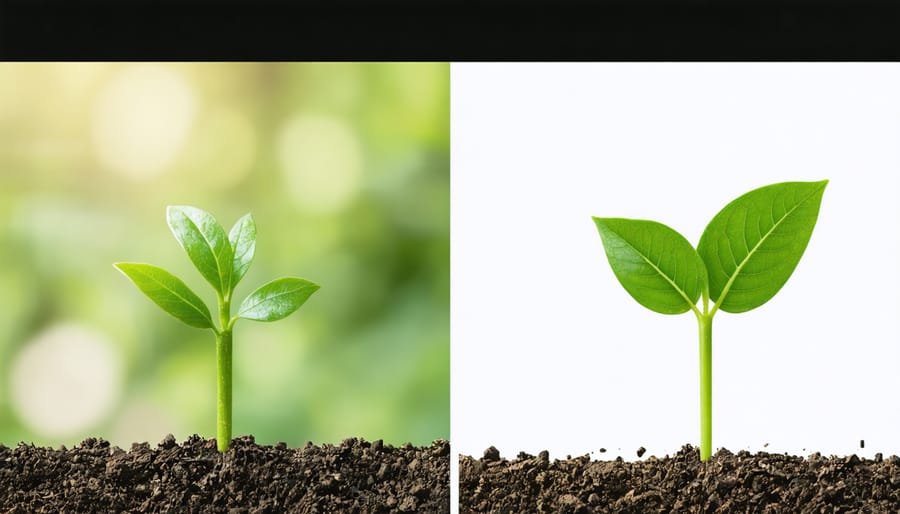
Common Challenges and Solutions
Building healthy organic soil isn’t always a smooth journey, but don’t worry – every gardener faces similar challenges. Let’s explore common issues and their practical solutions to help you succeed in your organic gardening endeavors.
One frequent challenge is soil that’s too acidic or alkaline. Many gardeners discover this when plants struggle to thrive despite their best efforts. The solution? Regular pH testing and natural amendments like lime to raise pH or sulfur to lower it. Remember to make adjustments gradually to avoid shocking your plants.
Compacted soil is another common hurdle, especially in areas with heavy clay. This can prevent root growth and proper water drainage. Combat this by adding organic matter like compost and incorporating cover crops that naturally break up soil with their root systems. Using raised beds can also help you start fresh with well-structured soil.
Nutrient deficiencies often frustrate gardeners, showing up as yellowing leaves or stunted growth. Instead of reaching for synthetic fertilizers, try organic solutions like compost tea, well-rotted manure, or specific organic amendments like blood meal for nitrogen or bone meal for phosphorus. The key is regular, small additions rather than large, occasional applications.
Managing soil moisture can be tricky – too much water leads to fungal issues, while too little stresses plants. Adding organic matter improves both drainage and water retention. Mulching with natural materials like straw or leaves helps maintain consistent moisture levels while suppressing weeds.
Beneficial microorganism populations sometimes struggle to establish, particularly in newly organic gardens. Encourage their growth by avoiding chemical pesticides and fertilizers, adding quality compost, and maintaining good soil moisture. Some gardeners successfully use microbial inoculants to jump-start this process.
Remember, building healthy soil is a gradual process. Be patient and consistent with your organic practices, and you’ll see improvement over time. Keep notes about what works in your garden – this information becomes invaluable as you continue your organic gardening journey.
Building healthy soil through organic practices is a rewarding journey that benefits not just your garden, but our entire ecosystem. As we’ve explored throughout this article, the key to successful gardening lies in nurturing the living world beneath our feet. By incorporating organic matter, maintaining proper soil structure, and supporting beneficial microorganisms, you’re creating a foundation for thriving plants and sustainable growing practices.
Remember, improving your soil is an ongoing process, not a one-time task. Start small by implementing one or two practices we’ve discussed, such as adding compost or mulching. As you become more comfortable with these methods, gradually incorporate other techniques into your gardening routine. The results may not be immediate, but your patience will be rewarded with healthier plants, better yields, and fewer garden problems over time.
Don’t be afraid to experiment and learn from both successes and setbacks. Every garden is unique, and what works best for your soil may take some trial and error to discover. Keep a garden journal to track your progress and observations, and connect with other gardeners in your community to share experiences and tips.
The journey to healthy soil begins with a single step – whether that’s starting your first compost pile or testing your soil pH. Your garden will thank you with abundant growth, and you’ll have the satisfaction of knowing you’re contributing to a healthier planet. Ready to get your hands dirty?

